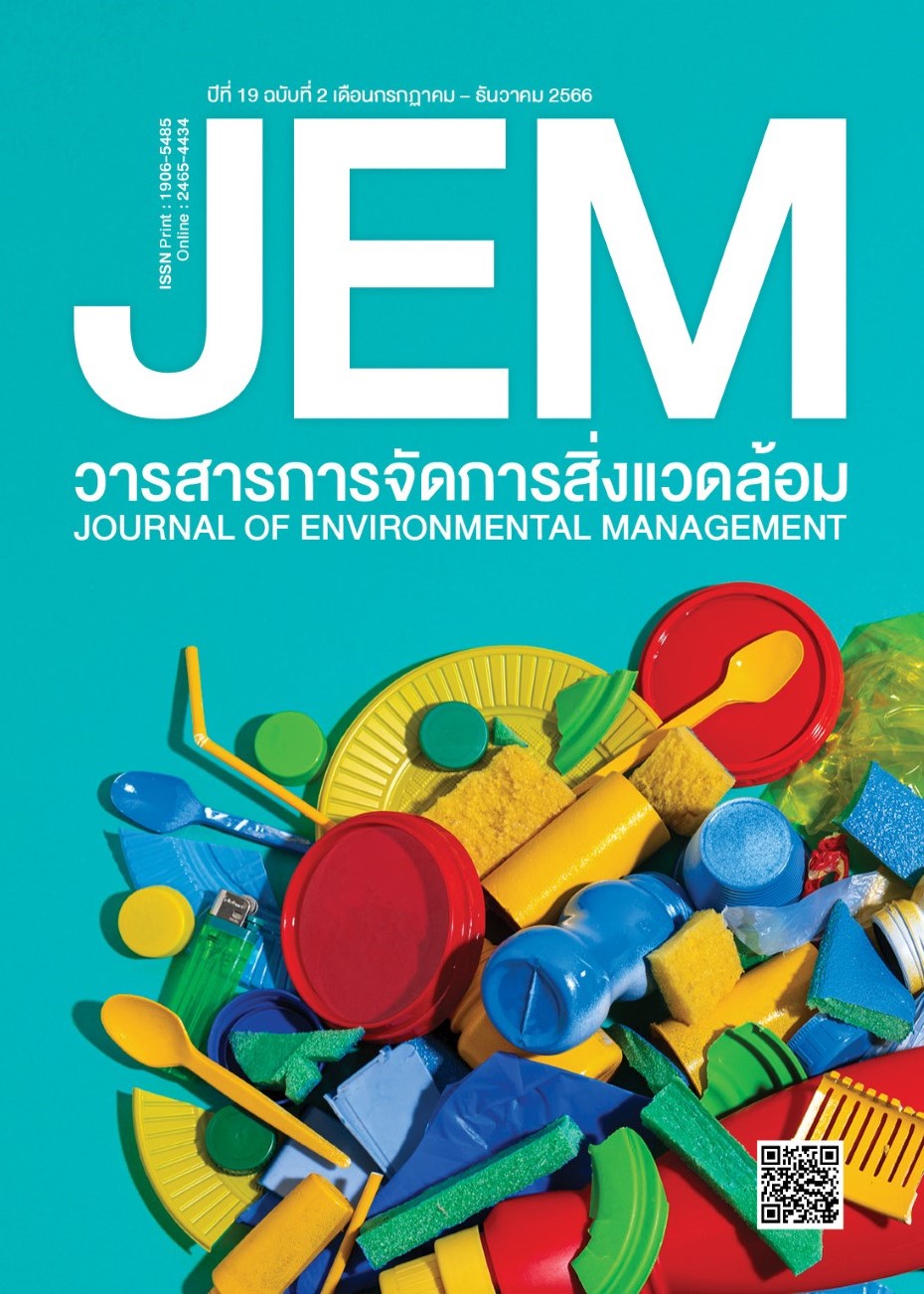การบริหารแหล่งมรดกโลกทางวัฒนธรรมบนฐานทรัพยากรที่มีคุณค่าโดดเด่นอันเป็นสากล กรณีศึกษา: ภูเขาไฟฟูจิ อุทยานแห่งชาติฟูจิ-ฮาโกเนะ-อิซึ ประเทศญี่ปุ่น
DOI:
https://doi.org/10.14456/jem.2023.11คำสำคัญ:
การบริหาร, ภูเขาไฟฟูจิ, แหล่งมรดกโลกทางวัฒนธรรม, คุณค่าโดดเด่นอันเป็นสากล , ญี่ปุ่นบทคัดย่อ
ภูเขาไฟฟูจิ เอกลักษณ์อันโดดเด่นของประเทศญี่ปุ่นเป็นที่รับรู้ของสากล และกลายเป็นคุณค่าโดดเด่นอันเป็นสากลของแหล่งมรดกโลกทางวัฒนธรรมฟูจิซัง ดินแดนอันศักดิ์สิทธิ์และสร้างแรงบันดาลใจทางศิลปะ ก่อให้เกิดการพัฒนาเพื่อรองรับการท่องเที่ยว โดยเฉพาะบนทางลาดของภูเขาไฟทรงกรวย จึงเป็นกรณีศึกษาของการศึกษาวิจัยในครั้งนี้ที่มุ่งศึกษาถึงการบริหารที่ดำรงไว้ซึ่งคุณค่าโดดเด่นอันเป็นสากลของภูเขาไฟฟูจิ โดยใช้วิธีการวิจัยเชิงคุณภาพรูปแบบปรากฏการณ์วิทยาแนวการตีความ จากข้อมูลที่ได้จากการศึกษาการสังเกตแบบมีส่วนร่วมในภาคสนาม ร่วมกับการวิจัยเชิงเอกสาร
ผลการวิจัยพบว่า ภูเขาไฟฟูจิมีเส้นทางเข้าถึงจำนวน 4 เส้นทางหลัก กระจายโดยรอบภูเขาไฟฟูจิ ทุกเส้นทางจะเริ่มต้นด้วยเส้นทางถนนจากบริเวณเนินเขาด้านล่าง ไปยังบริเวณสถานที่ 5 ที่มีการพัฒนารองรับการท่องเที่ยวมากน้อยแตกต่างกันไป เพื่อเป็นสถานีที่เชื่อมต่อไปยังเส้นทางเดินเท้าบนเขาไปยังปากปล่องภูเขาไฟ ระหว่างเส้นทางเดินเท้าขึ้นบนเขาก็จะมีกระท่อมตามเส้นทางสำหรับให้นักท่องเที่ยวได้พักค้าง การบริหารจัดการแหล่งมรดกโลกฟูจิซังดำเนินการโดยสภามรดกโลกทางวัฒนธรรมฟูจิซัง ที่ต้องดำเนินงานตามข้อเสนอแนะของคณะกรรมการมรดกโลก ที่เกี่ยวกับสิ่งอำนวยความสะดวกทั้งเพื่อการสื่อความหมายและการเยี่ยมเยือน
เอกสารอ้างอิง
Aoki, Y., Tsunematsu, Y., & Yoshimoto, M. (2019). Recent progress of geophysical and geological studies of Mt. Fuji Volcano, Japan. Earth-Science Reviews, 194, 264-282.
Bacsi, Z., & Toth, E. (2019). World Heritage Sites as soft tourism destinations – their impacts on international arrivals and tourism receipts. Bulletin of Geography. Socio-economic Series, 45(2019), 25–44.
Bowman, M., Davies, P., & Redgwell, C. (2010). The Convention on the Conservation of European Wildlife and Natural Habitats. In Lyster’s International Wildlife Law (pp. 297-345). Cambridge University Press, Cambridge.
Cameron, C., & Rössler, M. (2016). Many Voices, One Vision: The Early Years of the World Heritage Convention. Routledge, London.
Chakraborty, A., & Jones, T.E. (2018). Mount Fuji: The Volcano, the Heritage, and the Mountain. In: Chakraborty, A., Mokudai, K., Cooper, M., Watanabe, M., Chakraborty, S. (eds) Natural Heritage of Japan. Geoheritage, Geoparks and Geotourism. Springer, Cham. Retrieved January 25, 2023. from https://doi-org.portal.lib.ku.ac.th/10.1007/978-3-319-61896-8_16.
Council for the Promotion of the Proper Use of Mt. Fuji. (2016). Mt. Fuji Climbing. Retrieved Retrieved January 25, 2023. from http://www.fujisan-climb.jp/en/index.html.
Dallen, J.T., & Boyd, S.W. (2003). Heritage Tourism. Pearson Education, Harlow, UK.
Earhart, H. B. (1989). Mount Fuji and Shugendo. Japanese Journal of Religious Studies, 16(2/3),
–226.
Earhart, H. B. (2011). Mount Fuji: Icon of Japan. University of South Carolina Press, Columbia.
Francioni, F. (2012). Forty years on: World Heritage and international law. World Heritage No.63. Retrieved January 22, 2023. from https://unesdoc.unesco.org/ark:/48223/pf0000216530.
Holleland, H., Hamman, E., & Phelps, J. (2019). Naming, Shaming and Fire Alarms: The Compilation, Development and Use of the List of World Heritage in Danger. Transnational Environmental Law, 8(1), 35-57.
Japan National Tourism Organization. (2022). Open Spiritual Experience with the Way of Shugendo. Retrieved January 22, 2023. from https://www.japan.travel/th/th/newsletter/exploringshugendo-all-around-Japan.
Japan Endless Discovery. (2023). How to climb Mt. Fuji, Japan’s most famous peak. Retrieved January 24, 2023. from https://www.japan.travel/en/fuji-guide/mt-fuji-climbing-guide.
Jokilehto, J. (2006). World Heritage: Defining the outstanding universal value. City & Time, 2(2).
Jones, T. E., & Yamamoto, K. (2016). Segment-based monitoring of domestic and international climbers at Mouth Fuji: Targeted risk reduction strategies for existing and emerging visitor segments. Journal of Outdoor Recreation and Tourism, 13, 10-17.
Kumpang, P. (2014). WINDOWS ON THE WORLD; JAPAN. Windows on the world, Bangkok.
Maruyama, J., Tiemsingha, A., & Youngkong, J. (2010). FuJisan. S. Asiaplus (1999), Bangkok.
Meskell, L., & Liuzza, C. (2022). The world is not enough: New diplomacy and dilemmas for the World Heritage Convention at 50. International Journal of Cultural Property, 1-17.
Miura, K. (2022). A dilemma of World Heritage ideals and challenges in Southeast Asia. International Journal of Cultural Property, 1-25.
Murakushi, N. (2003). The Establishment of Fuji-Hakone National Park (3). Retrieved January 23, 2023. from https://eds.p.ebscohost.com/eds/detail/detail?vid=9&sid=45042e45-9338-4962-9bc5-d013a13de8b0%40redis&bdata=JnNpdGU9ZWRzLWxpdmU%3d#AN=edsbas.F9830365&db=edsbas8.
Murakushi, N. (2021). A Critical Review of the Construction Plan for the Mt. Fuji Mountain Railway Drafted by the Yamanashi Prefecture Authorities. Retrieved January 23, 2023. From https://eds.p.ebscohost.com/eds/detail/detail?vid=6&sid=45042e45-9338-4962-9bc5-d013a13de8b0%40redis&bdata=JnNpdGU9ZWRzLWxpdmU%3d#AN=edsbas.B59C22F0&db=edsba.
National Parks of Japan. (2023). Explore Fuji-Hakone-Izu National Park. Retrieved January 24, 2023. from https://www.japan.travel/ national-parks/parks/fuji-hakone-izu/explore.
Podhisita, C. (2021). Science and art of quantitative research: Manual for student and social science researcher. Amarin printing and publishing, Bangkok.
Sawada, J. A. (2022). Faith in Mount Fuji: The Rise of Independent Religion in Early Modern Japan. University of Hawaii Press, Hawaii.
Sekimori, G. (2002). Shugendo: The State of the Field. Monumenta Nipponica, 57(2), 207–227.
Siriprakob P. (2022). Japanese public administration. Chulalongkorn University Press, Bangkok.
Southall, C., & Robinson, P. (2011). Heritage tourism. Retrieved January 24, 2023. from https://doi-org.porttal.lib.ku.ac.th/10.1079/9781845936846.0176.
Thai World Heritage Information Center. (2023). The World Heritage Convention. Retrieved January 23, 2023. from http://164.115.22.96/convention-th3.aspx.
Wager, J. (1995). Environmental planning for a World Heritage Site: case study of Angkor, Cambodia. Journal for Environmental Planning and Management, 38, 419–434.
Ukawa, M. (2005). Deep low-frequency earthquake swarm in the mid crust beneath Mount Fuji (Japan) in 2000 and 2001. Bulletin of Volcanology, 68, 47–56.
UNESCO World Heritage Convention. (2023). Fujisan, sacred place and source of artistic inspiration. Retrieved January 24, 2023. from https://whc.unesco.org/en/list/1418.



